This article accompanies Innovating for the Future.
It’s only been two years since Krista Simonsen joined the National 4-H Council, a youth-development organization based in Chevy Chase, Md., that supports 140 employees. Since then, she has been promoted from HR manager to HR director and has transformed the way employees are recruited, engaged and rewarded while aligning HR with the organization’s business goals and talent strategies.
When she came on board, the organization was facing problems.
“It was a tumultuous time for the HR team,” says Simonsen, who earned a bachelor of arts degree from the University of Buffalo in 2011 and two professional certifications: SHRM-CP (certified professional) and PHR (professional in HR). “There was a lack of HR leadership, some turnover and no direction in terms of overall strategy. I had to build trust in the HR department, [ensuring] the team was consistent and competent.”
Among her first responsibilities was introducing a pay-for-performance model and internal salary-grading system in an organization that applied traditional approaches to pay raises. To solicit buy-in from staff for both systems, she revised and streamlined existing performance-appraisals forms, created supplemental worksheets that informed employees about the new process, provided tip sheets that helped employees create developmental goals and offered training workshops and individual coaching sessions for supervisors.
Although employees may have been “overeducated” about the new process, she says, it was important that they fully understood why the council was transitioning to a performance-based culture and how it would support and encourage professional development for both staff and the organization.
“The strongest message this sends is that we’re a results-driven environment, and you will be rewarded if you work hard and meet our goals,” she says, adding that she also works with C-suite executives and board members to identify high-potential employees and create individual professional-development strategies. “Trust has built up around the program.”
Shaking Things Up
In recent years, the organization has supported a large number of employees who telecommuted but felt disconnected from–and maybe even undervalued by–the council.
To address that issue, in 2017, Simonsen rolled out an annual rewards and recognition program that was aligned with the organization’s culture. Employees can nominate peers who champion or demonstrate any of the organization’s 10 valued behaviors, such as establishing strong connections with members from their team or community. The selection committee, composed of HR staff and past winners, chooses 10 winners, or two individuals who reflect each of the council’s five values. Each winner is awarded $1,000.
Likewise, the HR team beefed up the employee-referral program. In the past, she says, the finder’s fee ranged from $100 to $250. Now, the program pays either $500 for referring an hourly applicant or $1,000 for a salaried candidate who is hired; targeted emails remind employees of the program.
Simonsen says HR also consolidated and centralized recruiting by hiring a full-time, dedicated consultant to maintain compliance and enhance the hiring manager and candidate experiences. An exit-interview process was established, enabling Simonsen to aggregate feedback from departing employees and then share it with board members. HR began using an applicant-tracking system that it had already purchased as part of its HRIS but never used. Attention also shifted toward individual professional development, since few employees shared the same job title or responsibilities.
“There was a real strong financial and strategic push to have full organizational training, where 100 people would get in a room and [receive training] on a specific topic,” she says, adding that attendance was low, learning didn’t really stick and external trainers were costly. “Now, HR encourages managers to meet with each direct associate at least once a week to identify skills or professional development needed. We partner with them to identify potential training opportunities.”
But associates weren’t the only individuals learning. Simonsen says she better understands the importance of analytics, especially for providing concrete results to the council’s leaders and senior members. Over the past two years, she has grown more comfortable with numbers and is more competent at applying hardcore metrics when addressing issues, trends or solutions with the leadership team.
Future CHRO
Simonsen’s boss, Jane Angelich, senior vice president and chief innovation officer at the council, says Simonsen’s “quiet assertiveness” is among her standout characteristics.
“Krista’s strong suit is her ability to communicate and influence our senior leadership while maintaining respect across the entire organization,” she says. “I’m continually impressed with her [understanding of] organizational agility and ability to maintain a calm demeanor. She gets what she needs to get across in all parts of the organization, but she doesn’t operate like a bull in a china shop.”
Angelich says Simonsen is on track for one more promotion–to CHRO–within the next three years, mainly because she has embraced her role with a “huge amount of passion and a great deal of speed.”
Simonsen, however, believes her accomplishments are more the outcome of the trust and confidence placed in her by the council’s leaders.
“It’s only through that trust that I’ve been able to … build as many programs in the short time I’ve been with the organization,” she says. “It’s fantastic for the organization and also fantastic for my team and my development.”

